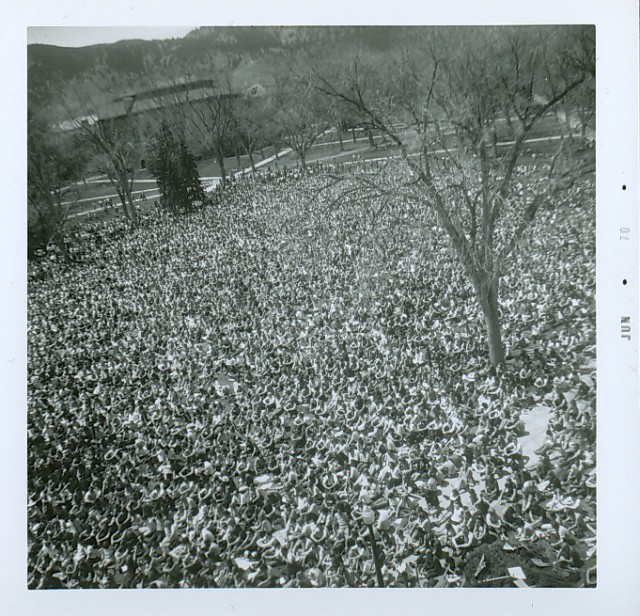
Turbulent is one of those words people use to simplify immensely complex situations into something easily understood.
That’s the case for 1968, an undoubtedly turbulent year in America’s history.
Martin Luther King Jr. was assassinated April 4. Robert Kennedy, June 5. Student protests and anti-war rallies shut down campuses nationwide. Black power, The White Album, 2001: A Space Odyssey, Richard Nixon — turbulence everywhere.
That upheaval is now framed under glass at the Boulder History Museum’s revealing exhibit, 1968 in America. The exhibit, housed inside the museum at 1206 Euclid Ave., presents artifacts, quotes and videos that illustrate the social and cultural changes the country — with an emphasis on Boulder — endured around that time.
If a museum exhibit isn’t your cup of tea, your cup of tea is probably a cocktail. Which means “Hippies and Hipsters,” a dance party at the Hotel Boulderado’s new Club B, might be your style. The monthly dance party has picked the 1960s as its theme to coincide with the museum’s exhibit.
The changes the ’60s brought to Boulder were monumental. It’s hard to believe, but Boulder was a conservative town before 1968. The college was always somewhat liberal, says Boulder History Museum CEO Nancy Geyer, but the town as a whole wasn’t particularly progressive. Then the hippies came.
“The hippie invasion did happen in ’68,” she says. “It was a college town, a beautiful place, and around that time the natural foods movement started here.”
Thousands of hippies moved to the area from California, but Geyer says divisions among young people didn’t last long.
“I was on 28th Street when we got tear-gassed protesting the Vietnam War,” Geyer says. “And I’m not what you’d call a hippie. I don’t know how many people at that time would call themselves hippies.
“When you’re in the middle of it, you don’t think about labels,” she says. “It wasn’t like the hippies were all together on a bus or something.”
The museum’s exhibit shows as much, illustrating how the demand for change spread to include a huge range of young people.
“I think Boulder was in that kind of transition period,” Geyer says. “It was the coming of age of the Baby Boomer generation. There was suddenly this big population of young people.”
The exhibit shows how young people affected the country in its four parts: the Power of Idealism, the Power of Music, the Power of the Bullet and the Power of the Press. In each area, Boulder institutions — like the Caribou Ranch recording studio outside Nederland — are featured.
“Our intent with the exhibit was to show how 1968 was a transitional time,” Geyer says. “And Boulder was part of that.”
Beverly Silva, director of sales and marketing at the Boulderado, says she expects the Club B crowd to fully embrace what the ’60s meant, including fashion.
“That’s always a big hit when we have these theme parties,” Silva says. “It seems like in our town, people really like to get into costume. They don’t just do it on Halloween.”
She emphasizes that costumes are optional. Club B will offer prizes for best-dressed male and female, including overnight stays as the Boulderado and certificates to Q’s Restaurant.
Club B has hosted two previous dance parties in the Boulderado’s events center. Silva says the draw is a dance club that might actually be welcoming and inviting.
“A lot of places you go for dancing or to see a band or a DJ, it’s a sticky floor, and there’s nowhere to sit down,” she says. “We put down a dance floor in the center of the room and have cocktail-style seating.”
Silva says the nicer atmosphere might be the reason Club B tends to attract a slightly older crowd than a typical dance club.
“I would say 30s, 40s and 50s is the demographic we cater to,” she says.
Past Club B parties have featured DJs playing tracks from the appropriate era. This month, local band Hindsight will join the DJ and play covers of ’60s-era songs. Boulder Weekly Publisher Stewart Sallo is a member of Hindsight.
Silva says outside of dancing, Club B will offer a long list of other activities, including a documentary on Woodstock, hula-hoop and fire dancers, and event photography from WiCam. Partygoers can pick up digital cameras from WiCam to use throughout the night; the photos they take are projected on large screens at the event.
“We get these great photos not just from one angle,” Silva says. “It becomes interactive for people.”
It’s a few steps beyond anything they had in 1968, maybe, but it’s all in the spirit of celebrating the ’60s and having fun.
Respond: [email protected]
On the Bill:
For more information on the Boulder History Museum, visit boulderhistory.org. For more information on Hotel Boulderado’s Club B, visit www.boulderado.com/clubb.html.














